Last week, after the Nexus 7 launch event in San Francisco, Sundar Pichai of Google, head of both the Android and Chrome teams, dropped a particularly interesting aside into one of his comments to the assembled press: “Our goal is to put computing everywhere.”
That’s a subtle but important additional goal for a company that is explicitly built to “organize the world’s information.” It indicates, among other things, that creating hardware, or at least partnering with companies that do, is now an essential part of gathering, processing and distributing that information.
In other words, Google is a company that is already well aware that to survive the coming decade, it must outgrow the web.
Multiplying the number of microchips in our lives
Pichai was answering a question about whether or not Google would ever create a super-phone that could replace a desktop PC, like Ubuntu’s Edge. And it was clear from his answer, not to mention the presentation that had just concluded, which included Google’s new Nexus 7 tablet and the Chromecast smart television device, that Google is pushing in the opposite direction: getting microprocessors into any place they might possibly be useful.
Google CEO Larry Page, who has made great strides in recent years in terms of focusing Google on just a handful of core projects, is clearly also pushing for the company to move further into making hardware. Here’s what he said about it on the company’s most recent earnings call:
I think it’s always a mistake to assume that technology will be static. So, I think certainly over the long term, we’re going to have new kinds of devices and ways of interacting with computing and the Internet.
We’re obviously excited about Google Glass and new ways of interacting with hardware and new types of hardware. With any technological change you probably overestimate the short-term and underestimate the long-term. So, I think ou—we’re really excited about making those investments and making sure we’re positioned to the future.
Prototyping an internet of things
Now that Google’s Android mobile operating system is in at least one example of practically every “embedded” device on the market, it’s becoming the default operating system for the “Internet of Things,” which refers to a future in which all of our devices have the computing brains to sense, communicate and even interact with their environments.
“We used to make the joke that people could build refrigerators with Android in it, and then it happened,” says Hiroshi Lockheimer, head of Android engineering at Google.
Lockheimer says that Android engineers at Google don’t focus on embedded devices, but because Android is open source and any other company can use it, many repurpose it for that. That translates into a huge amount of free engineering talent that is constantly working to make Android better, fix bugs and adapt it to new gadgets. That means contributions of code from programmers outside Google, as well as a much larger base of engineers who are familiar with Android, says Lockheimer, which leads to even more Android-powered devices.
Google still makes nine out of every ten of its dollars of revenue from advertisements it places alongside our search results and emails, but the increasing visibility and influence of Google’s Android team, which now includes both hardware and software engineers, shows how far the company has come, and how it’s shaping a future in which data flows into and out of Google’s hive mind from devices. Those include Google Glass and sensor-studded personal location devices, which are alien to our current conception of personal computing.
